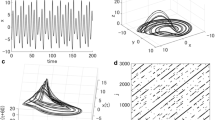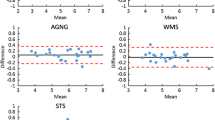Abstract
Current methods to infer an agent’s state of attentional focus rely on scalp potential recordings and pupil diameter measurements, both of which are unrealistic in many real-world situations, and are also prone to movement and electrical artifacts. Being able to predict attentional performance from a simple and noninvasive measure, such as respiration, could have obvious potential benefit for simplifying measurement and improving task performance in many settings, and could also be employed clinically with attentionally compromised populations for training and rehabilitation. It has been suggested that respiration and attention comprise a neuro-physiologically coupled system, and behavioral data has indicated that attentional performance, including reaction time and reaction time variability (RTV), covary with respiratory dynamics. In the present study, we tested several neural network configurations for the prediction of attentional control state (RTV) from respiratory parameters. We observed significant predictive power derived solely from respiratory input, and conclude that a robust and portable feedback device utilizing soft computation is feasible for this purpose. We suggest specific model and data source improvements to potentially further reduce errors in prediction.













Similar content being viewed by others
References
Ardabili SF, Najafi B, Shamshirband S, Bidgoli BM, Deo RC, Chau KW (2018) Computational intelligence approach for modeling hydrogen production: a review. Eng Appl Comput Fluid Mech 12(1):438–458
Duta M, Alford C, Wilson S, Tarassenko L (2004) Neural network analysis of the mastoid EEG for the assessment of vigilance. Int J Hum Comput Interact 17(2):171–195
Fotovatikhah F, Herrera M, Shamshirband S, Chau KW, Faizollahzadeh Ardabili S, Piran MJ (2018) Survey of computational intelligence as basis to big flood management: challenges, research directions and future work. Eng Appl Comput Fluid Mech 12(1):411–437
Gorus E, De Raedt R, Lambert M, Lemper JC, Mets T (2008) Reaction times and performance variability in normal aging, mild cognitive impairment, and Alzheimer’s disease. J Geriatr Psychiatry Neurol 21(3):204–218. https://doi.org/10.1177/0891988708320973
Jackson JD, Balota DA, Duchek JM, Head D (2012) White matter integrity and reaction time intraindividual variability in healthy aging and early-stage Alzheimer disease. Neuropsychologia 50(3):357–366. https://doi.org/10.1016/j.neuropsychologia.2011.11.024
Jafari S, Arabalibeik H, Agin K (2010) Classification of normal and abnormal respiration patterns using flow volume curve and neural network. In: 2010 5th international symposium on health informatics and bioinformatics (HIBIT). IEEE, pp 110–113
Jensen AR (1992) The importance of intraindividual variation in reaction time. Personality Individ Differ 13(8):869–881
Jung TP, Makeig S (1994) Estimating level of alertness from EEG. In: Engineering in medicine and biology society, 1994. Engineering advances: new opportunities for biomedical engineers. Proceedings of the 16th annual international conference of the IEEE, vol 2. IEEE, pp 1103–1104
Jung TP, Makeig S, Stensmo M, Sejnowski TJ (1997) Estimating alertness from the EEG power spectrum. IEEE Trans Biomed Eng 44(1):60–69
Kofler MJ, Rapport MD, Sarver DE, Raiker JS, Orban SA, Friedman LM, Kolomeyer EG (2013) Reaction time variability in ADHD: a meta-analytic review of 319 studies. Clin Psychol Rev 33(6):795–811. https://doi.org/10.1016/j.cpr.2013.06.001
Lee HK (2001) Model selection for neural network classification. J Classif 18(2):227–243
Makeig S, Jung TP, Sejnowski TJ (1996) Using feedforward neural networks to monitor alertness from changes in EEG correlation and coherence. In: Advances in neural information processing systems, pp 931–937
Melnychuk MC, Dockree PM, O’Connell RG, Murphy PR, Balsters JH, Robertson IH (2018) Coupling of respiration and attention via the locus coeruleus: effects of meditation and pranayama. Psychophysiology 55(9):e13091
Melnychuk MC, Dockree PM, Murphy PR, Balsters JH, Robertson IH. Respiration and attention: covariance and synchronization (Manuscript in Preparation)
Moazenzadeh R, Mohammadi B, Shamshirband S, Chau KW (2018) Coupling a firefly algorithm with support vector regression to predict evaporation in northern Iran. Eng Appl Comput Fluid Mech 12(1):584–597
Muktibhodananda S (2013) Hatha Yoga Pradapika, 3rd edn. Bihar School of Yoga Publishers, Bihar
Murphy PR, O’Connell RG, O’Sullivan M, Robertson IH, Balsters JH (2014) Pupil diameter covaries with BOLD activity in human locus coeruleus. Hum Brain Mapp 35(8):4140–4154
Nabavi-Pelesaraei A, Rafiee S, Mohtasebi SS, Hosseinzadeh-Bandbafha H, Chau KW (2018) Integration of artificial intelligence methods and life cycle assessment to predict energy output and environmental impacts of paddy production. Sci Total Environ 631:1279–1294
Najafi B, Ardabili SF, Shamshirband S, Chau KW, Rabczuk T (2018) Application of ANNs, ANFIS and RSM to estimating and optimizing the parameters that affect the yield and cost of biodiesel production. Eng Appl Comput Fluid Mech 12(1):611–624
Sai V (2010) Ananda Sutra. Sri Vasantha Sai Books and Publications Trust, Royapalyam
Satchidananda SS (2012) The Yoga Sutras of Patanjali, Reprint edn. Integral Yoga Publications, Yogaville
Tamm L, Narad ME, Antonini TN, O’Brien KM, Hawk LW Jr, Epstein JN (2012) Reaction time variability in ADHD: a review. Neurotherapeutics 9(3):500–508. https://doi.org/10.1007/s13311-012-0138-5
Tse CS, Balota DA, Yap MJ, Duchek JM, McCabe DP (2010) Effects of healthy aging and early stage dementia of the Alzheimer’s type on components of response time distributions in three attention tasks. Neuropsychology 24(3):300–315. https://doi.org/10.1037/a0018274
Vuckovic A, Radivojevic V, Chen AC, Popovic D (2002) Automatic recognition of alertness and drowsiness from EEG by an artificial neural network. Med Eng Phys 24(5):349–360
Whyte J, Polansky M, Fleming M, Coslett HB, Cavallucci C (1995) Sustained arousal and attention after traumatic brain injury. Neuropsychologia 33(7):797–813. https://doi.org/10.1016/0028-3932(95)00029-3
Wilson BJ, Bracewell TD (2000) Alertness monitor using neural networks for EEG analysis. In: Neural networks for signal processing X. Proceedings of the 2000 IEEE signal processing society workshop (Cat. No. 00TH8501), vol 2, pp 814–820. IEEE
Yaseen ZM, Sulaiman SO, Deo RC, Chau KW (2019) An enhanced extreme learning machine model for river flow forecasting: state-of-the-art, practical applications in water resource engineering area and future research direction. J Hydrol 569:387–408
Zadeh LA (1998) Some reflections on soft computing, granular computing and their roles in the conception, design and utilization of information/intelligent systems. Soft Comput 2(1):23–25
Funding
MM and PD were supported by Irish Research Council Laureate Grant: 201911.
Author information
Authors and Affiliations
Corresponding author
Ethics declarations
Conflict of interest
The authors declare no conflict of interest, and this work does not infringe on copyright of other publications from our group.
Additional information
Publisher's Note
Springer Nature remains neutral with regard to jurisdictional claims in published maps and institutional affiliations.
Rights and permissions
About this article
Cite this article
Melnychuk, M.C., Murphy, P.R., Robertson, I.H. et al. Prediction of attentional focus from respiration with simple feed-forward and time delay neural networks. Neural Comput & Applic 32, 14875–14884 (2020). https://doi.org/10.1007/s00521-020-04841-7
Received:
Accepted:
Published:
Issue Date:
DOI: https://doi.org/10.1007/s00521-020-04841-7




